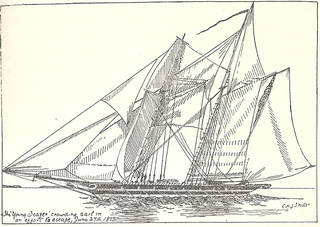Citations
- ↑ Lloyd's Register (1818), seq.no.L357.
- ↑ Clarke, James. (1875) Memorials of the Clarke Family . (Indianapolis Printing and Publishing House).
Several vessels have been named Liverpool Packet:

Liverpool is a Canadian community and former town located along the Atlantic Ocean of the Province of Nova Scotia's South Shore. It is situated within the Region of Queens Municipality which is the local governmental unit that comprises all of Queens County, Nova Scotia.

Joseph Barss was a sea captain of the schooner Liverpool Packet and was one of the most successful privateers on the North American Atlantic coast during the War of 1812.

HMS Fantome was an 18-gun brig-sloop of the Royal Navy. She was originally a French privateer brig named Fantôme, which the British captured in 1810 and commissioned into British service. Fantome saw extensive action in the War of 1812 until she was lost in a shipwreck at Prospect, Nova Scotia, near Halifax in 1814.

HMS Belvidera was a Royal Navy 36-gun Apollo-class frigate built in Deptford in 1809. She saw action in the Napoleonic Wars and the War of 1812 and continued a busy career at sea into the middle of the 19th century. In 1846 she was reduced to harbour service, in 1860 she became a receiving ship, and she was finally disposed of in 1906.
Liverpool Packet was originally the American slave ship Severn, built at Baltimore and captured in 1811. She became a privateer schooner from Liverpool, Nova Scotia, that captured 50 American vessels in the War of 1812. American privateers captured Liverpool Packet in 1813, but she failed to take any prizes during the four months before she was recaptured. She was repurchased by her original Nova Scotia owners and returned to raiding American commerce. Liverpool Packet was the most successful privateer vessel ever to sail out of a Canadian port.
Ten ships of the Royal Navy have borne the name HMS Magnet:
USS Rattlesnake was the brig Rambler built in Medford, Massachusetts, in 1812 that the United States Navy purchased in July 1813. Rattlesnake captured numerous British merchant vessels before HMS Leander captured her in mid-1814. The Royal Navy apparently purchased her at Nova Scotia, but there is no record of her subsequent career.

Young Teazer was a United States privateer schooner that captured 12 British vessels, five of which made it to American ports. A member of her crew blew her up at Mahone Bay, Nova Scotia during the War of 1812 after a series of British warships chased her and after HMS Hogue trapped her. The schooner became famous for this deadly explosion, which killed most of her crew, and for the folklore about the ghostly "Teazer Light."

HMS Epervier was an 18-gun Cruizer-class brig-sloop of the Royal Navy, built by Ross at Rochester, England, and launched on 2 December 1812. USS Peacock captured her in 1814 and took her into service. USS Epervier disappeared in 1815 while carrying dispatches reporting the signing of a treaty with the Dey of Algiers.

Rossie was a schooner launched at Baltimore in 1807. At the outbreak of the War of 1812 she became a privateer, operating under a letter of marque. She made two voyages, the first as a privateer, and the less successful second as a letter of marque. The British captured her in January 1813.
A number of vessels have been named Alexander:
Charles Mary Wentworth was a privateer ship built in 1798 by local investors in Liverpool, Nova Scotia, the first privateer ship from British North America in the Napoleonic Wars. The ship was named after Charles Mary Wentworth, the son of then governor of Nova Scotia, Sir John Wentworth. The ship Charles Mary Wentworth launched privateering in Nova Scotia during the Napoleonic Wars. Her success in capturing 11 valuable ships in her short two-year career led to the commissioning of a dozen other privateer ships from Nova Scotia.
Several ships have been named Princess Amelia:
Several vessels have been named Harriet, or Harriot:
Several vessels have borne the name John Bull, named for the figure John Bull:
Invincible Napoleon was a three-masted French privateer commissioned in Bayonne in Spring 1804. She made numerous cruises until 1813–1814 when the British and the Americans repeatedly captured her. In her brief career as an American privateer she captured some 14 vessels. She finally ended up in British hands and was taken to Halifax, Nova Scotia as a prize.
Several ships have been named Severn for the River Severn:
Several vessels have been named Tartar:
Several vessels have been named Pursuit: